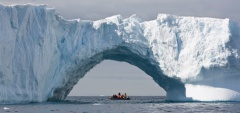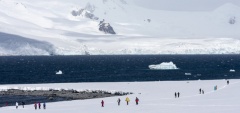How to go to Antarctica
One of the most difficult decisions in planning a cruise to Antarctica is deciding how to get there! In an effort to try and simplify the large amount of information out there we have put together a quick guide on how to get to Antarctica.
In reality, there are two main ways to get to Antarctica, for those considering a cruise to the world's southernmost continent. The first is the most traditional route, and involves sailing across the Drake Passage from Ushuaia in Argentina. The second cuts out the tumultuous seas of the Drake Passage by flying from Punta Arenas in Chile to King George Island to meet your cruise vessel in the South Shetlands. Although there are a couple of other options, like departures from Buenos Aires or Puerto Madryn, which option you decide to go for will ultimately depend on preference and how the cruise fits into your wider travel plans in South America.
To help you decide, here are a few positives and negatives of each option:
Sail to Antarctica:
Crossing the Drake Passage by boat is still the most popular way to get to Antarctica. Setting sail from the port of Ushuaia, boats will sail through the Beagle Channel before sailing southwards across the Drake Passage.
Points in favour of sailing to Antarctica:
- The sense of achievement! For those with a sailing background or those interested in how the first explorers reached Antarctica, the Drake Passage crossing is an important part of the adventure. Seeing your first iceberg on the horizon will give you an idea of how the early explorers felt as they caught their first glimpse of the White Continent.
- For wildlife and birding enthusiasts, the Antarctic convergence offers the opportunity to see a variety of pelagic birds and sometimes whales. It’s also a chance to learn more about the Antarctic continent with presentations and talks by onboard experts.
- Sailing will give you the widest choice of departure dates, boats and voyages. For example, most itineraries to the Falklands and South Georgia will sail from Ushuaia.
- For the number of days you get on board, it offers better value for money.
Points against sailing to Antarctica:
- Sailing across the Drake Passage generally takes two days in both directions and therefore you are looking at a minimum 10 night voyage.
- The Drake Passage can be rough and for those who suffer from sea sickness, two days on board a rocky boat is a long time!
For more ideas, have a look at a couple of the most popular Sail Antarctica itineraries:
Fly and Cruise:
For those with less time on their hands or who are nervous about the Drake Passage crossing, the option of flying to Antarctica is a very attractive option! Departing from Chile’s southernmost city, Punta Arenas, you will fly to King George Island in the South Shetland Islands to meet your cruise boat and continue your journey to the Antarctic Peninsula.
Points in favour of flying to Antarctica:
- It condenses a two-day sea crossing into a two hour flight. Not only is this ideal for clients who are short on time, but it’s also convenient for those hoping to combine their Antarctica cruise with Patagonia and other parts of South America.
- It cuts out the rocky seas making for a more comfortable journey overall.
- The number of passengers on board the boat is often restricted by the number of people the plane can carry. This means the ship will often be half full and makes for a more personalised experience on board.
Points against flying:
- Due to Antarctic weather which can change quickly and unpredictably, (although rare) there is a potential for the flight to and from to Antarctica to be delayed. Flight departures are more susceptible to delays caused by weather than ships.
- Although there is a growing number of operators and boats offering fly and cruise itineraries, there isn’t as much choice as you get when sailing.
- The season for fly and cruise itineraries is generally quite a bit shorter than sailing itineraries.
- In general, fly and cruise itineraries work out to be more expensive.
Have a look at a couple of the main Fly and Cruise itineraries:
International Flights:
- If you’re coming from Sydney, New Zealand or Hong Kong, then you will find it easier to get to Punta Arenas than Ushuaia, as most international flights will fly into Chile’s capital, Santiago and from here it is an onward flight to Punta Arenas. This may be a point in favour of the fly and cruise itineraries.
- If you’re coming from the US or Canada, you should find it as easy to get to Chile or Argentina as most major airports offer direct or one-stop flights to both Santiago (for Punta Arenas) and Buenos Aires (for Ushuaia).
- If you’re travelling from the UK, British Airways offer direct flights to both Santiago and Buenos Aires meaning you should find it just as easy to reach Punta Arenas as Ushuaia.
Depending on how much time you have, you may want to combine your Antarctica cruise with a visit to the Torres del Paine National Park or a few days In Buenos Aires. If you’re hoping to tie your cruise into a larger trip through South America, then it may be worth looking at one of the cruises which starts in Ushuaia and finishes in Punta Arenas or vice versa.



